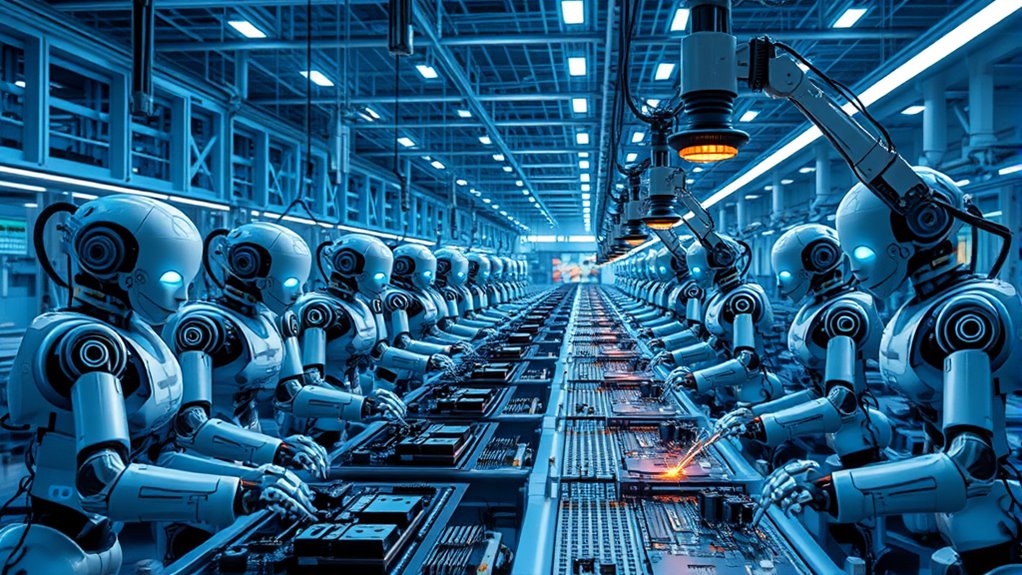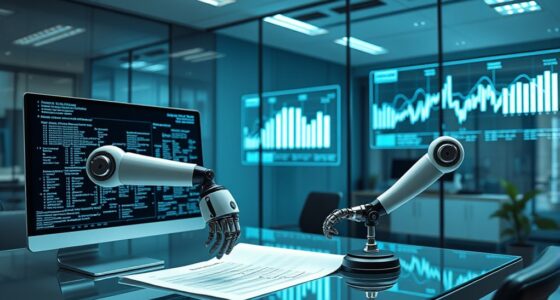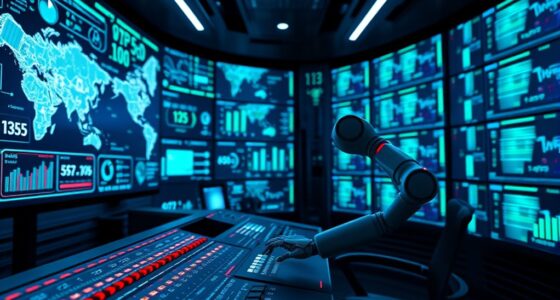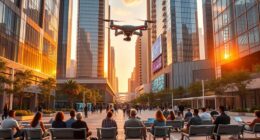By 2030, automation driven by advanced robots, AI, and connected technologies will transform your industry, making processes faster, more efficient, and highly precise. You’ll see increased use of predictive maintenance, real-time monitoring, and smarter quality control, reducing errors and downtime. Human roles will shift toward oversight and management, while robots handle more tasks. If you want to discover how these innovations can reshape your work environment and opportunities, there’s more to explore ahead.
Key Takeaways
- By 2030, automation will redefine industry standards, with robots handling most tasks and humans focusing on oversight and management.
- AI, IoT, and digital twins will enable real-time process optimization, predictive maintenance, and improved product quality.
- Sectors like manufacturing, pharmaceuticals, and energy will experience increased efficiency, safety, and sustainability through advanced automation.
- Workforce roles will shift toward higher-value skills, with significant job transformation and the creation of new employment opportunities.
- Challenges such as high initial costs, system compatibility, and workforce training will require strategic planning for successful automation integration.
The Current State of Industrial Automation and Market Growth
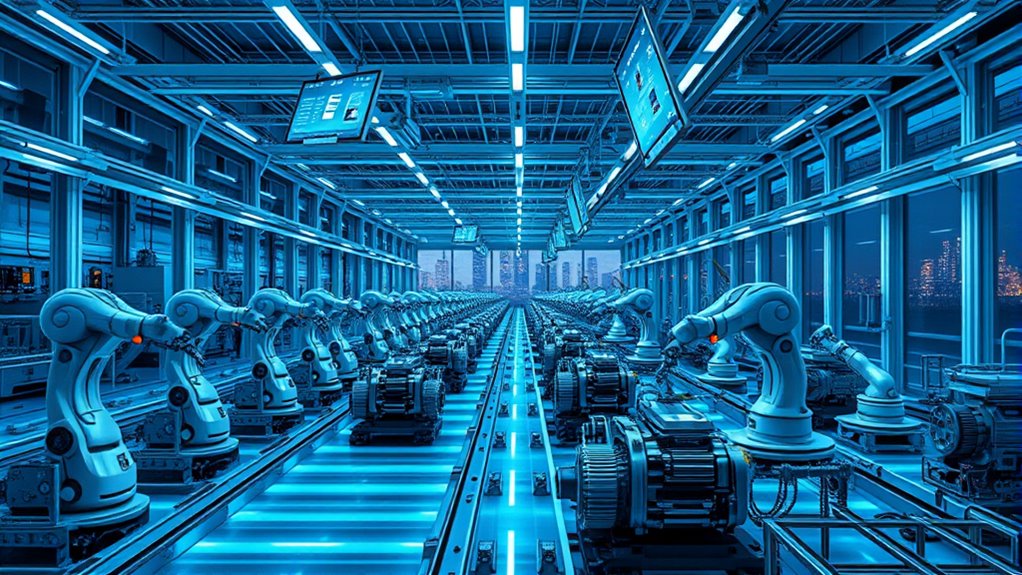
The industrial automation market is experiencing steady growth, driven by advancements in digital technologies and increasing demand for efficiency. In 2025, the global market was valued at USD 256.02 billion, and it’s projected to reach USD 569.27 billion by 2034, growing at a CAGR of 9.31%. Asia Pacific leads the way, surpassing USD 99.85 billion in 2025, with a growth rate of 9.45%. Other estimates place the market size between USD 226.76 billion and USD 265 billion. Recent trends show a slowdown in growth for 2024, but the momentum remains strong. Increased investments in robotics and IoT, coupled with a focus on operational efficiency, continue to fuel expansion across industries worldwide. Regional dynamics and economic factors shape the pace and scope of adoption. Despite the short-term slowdown, the industry is poised for a robust rebound and sustained growth through 2030. As adoption accelerates, the integration of automated systems is expected to become more sophisticated, further transforming industrial landscapes. Additionally, the integration of floating on water technologies is beginning to influence offshore and maritime automation solutions, with privacy policies playing a crucial role in managing data security and user trust. Furthermore, advancements in projector technology are enhancing visualization and control interfaces in industrial settings, enabling more precise monitoring and operational decision-making.
Key Technologies Driving Automation in Industries
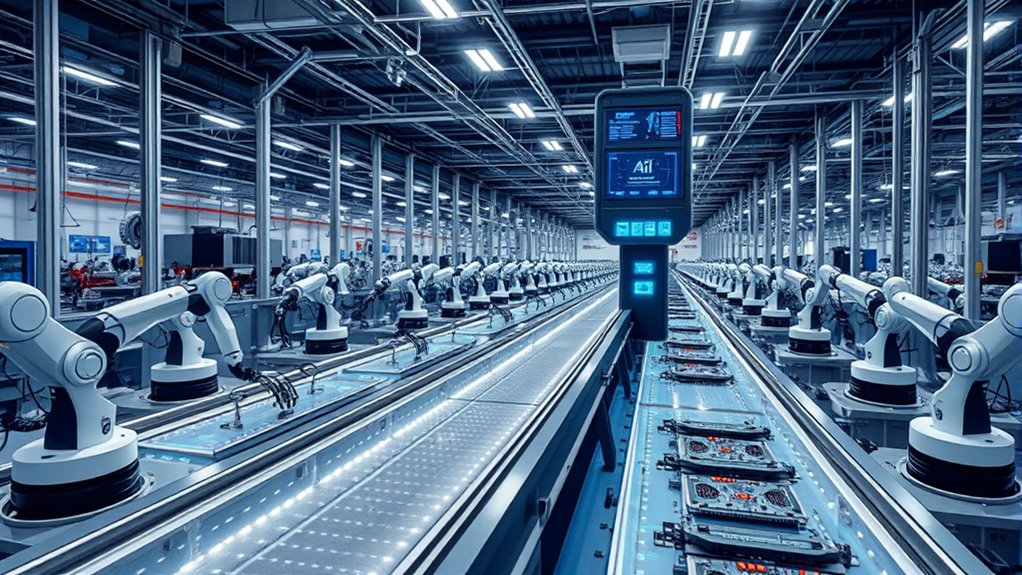
Advancements in key technologies are transforming industries by enabling smarter, more flexible automation systems. Soft PLCs give you the ability to program and adapt systems easily, integrating seamlessly with other devices. Digital twins let you create virtual models of physical processes, allowing real-time simulations and optimizations. Teach-less robotics eliminate the need for extensive training data, making robot deployment quicker and more flexible. IoT integration provides real-time monitoring and control, enhancing system responsiveness. Edge computing speeds up data processing and reduces latency, ensuring faster decision-making. Additionally, advancements in Honda Tuning have demonstrated how performance enhancements and customization options can be integrated into automotive manufacturing, showcasing the potential for automation in specialized industries. The integration of cybersecurity measures is also becoming essential to protect these interconnected systems from evolving threats. Implementing standardized protocols ensures compatibility and security across various automation components. As industries increasingly adopt these technologies, the importance of AI security to safeguard sensitive data and maintain trust continues to grow. Moreover, adopting industry-specific standards can facilitate smoother integration and compliance with regulatory requirements. By leveraging these innovations, you can improve productivity, reduce downtime, and stay competitive in an increasingly automated world.
How Automation Is Transforming Manufacturing Processes
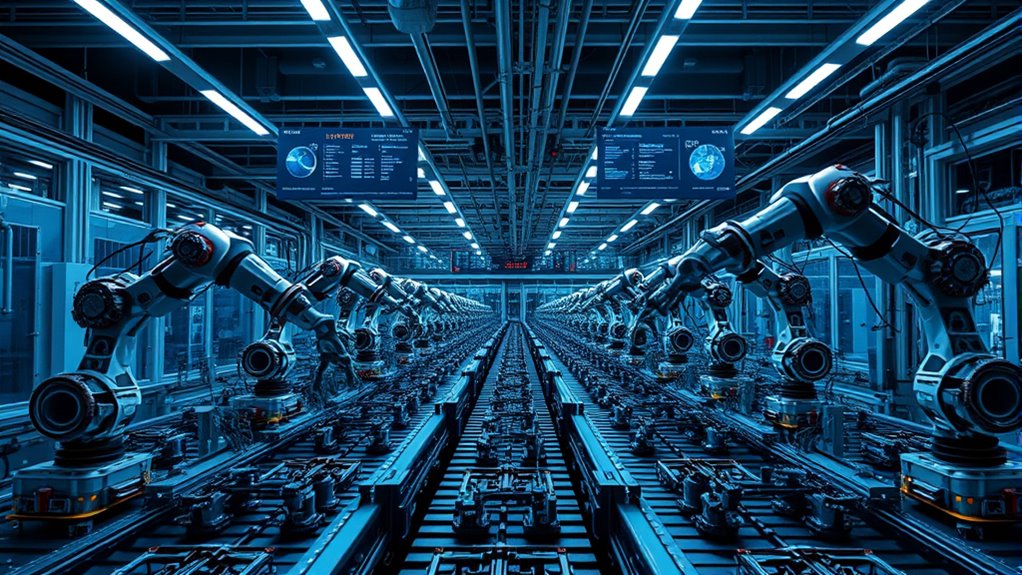
Automation is reshaping manufacturing by streamlining production lines, making operations faster and more efficient. It also improves quality control, ensuring consistent, high-quality products. Plus, automation enhances worker safety by reducing exposure to hazardous tasks and environments. Implementing vetted solutions can further optimize these benefits and ensure reliable performance. Additionally, integrating safety standards into automation systems helps prevent accidents and ensures compliance with regulations. Furthermore, embracing a creative practice mindset in automation development can foster innovative approaches to problem-solving, leading to more adaptable and resilient systems. Incorporating sound design techniques from trailer music can inspire novel automation interfaces that improve user experience and system responsiveness. Incorporating ongoing training and support for staff ensures the successful adoption and maintenance of automation technologies, maximizing their effectiveness.
Streamlining Production Lines
Streamlining production lines has become a key focus for manufacturing industries aiming to boost efficiency and adaptability. Automation technologies dramatically increase productivity by automating repetitive tasks, reducing manual errors, and optimizing workflows. You can lower labor costs since fewer workers are needed for routine operations. Advanced systems like IIoT enable real-time monitoring, allowing quick adjustments and process improvements. Automated systems also support consistent output through precise execution, indirectly enhancing quality. Predictive maintenance minimizes downtime by identifying equipment issues before failures occur. Additionally, automation allows for quick reprogramming of production lines, making it easier to adapt to changing demands or launch new products. Robotics integration and dynamic production planning ensure your processes remain flexible, efficient, and responsive in an evolving manufacturing landscape. Incorporating remote monitoring technology can also improve worker communication and safety in noisy environments. Moreover, integrating sound therapy science principles can help reduce stress and improve worker well-being in demanding production settings. Emphasizing the importance of biodiversity can also lead to more sustainable manufacturing practices that minimize environmental impact.
Enhancing Quality Control
As manufacturing processes become more complex, integrating automation is revolutionizing quality control in ways that were previously impossible. You’ll see the automated quality control market grow at a CAGR of 6.11%, reaching USD 1.12 billion by 2030, driven by AI and machine learning. These technologies enable real-time monitoring and predictive analytics, catching defects early and reducing errors. Industry 4.0 solutions connect networks for continuous data analysis, improving precision. Governments worldwide support this shift with incentives, tax breaks, and grants, encouraging adoption. Automation reduces costs by minimizing manual inspections and increases accuracy through automated defect detection. Market growth is supported by advances in sensing and robotics, leading to increasingly integrated, data-driven systems that adapt continuously. The rise of crypto regulation frameworks worldwide is also influencing manufacturing companies to adopt secure and compliant automation solutions, fostering greater trust and stability. As these advancements continue, your industry will benefit from faster, more reliable quality assurance, ultimately leading to higher product standards and customer satisfaction.
Increasing Workforce Safety
The integration of robotics and AI is considerably enhancing safety in manufacturing environments by reducing workers’ exposure to hazardous tasks and improving ergonomic conditions. Robots take on dangerous jobs, decreasing workplace injuries and fatalities, while AI monitors operations to spot signs of operator fatigue or unsafe behaviors. This proactive approach helps prevent accidents before they happen. Automation also improves ergonomic design, reducing musculoskeletal injuries. Modern systems ensure strict adherence to safety protocols and regulatory standards, minimizing human error. AI-driven predictive analytics provide early risk detection, and real-time monitoring catches unsafe behaviors or equipment malfunctions instantly. Additionally, these digital solutions facilitate rapid response to emergencies, ensuring that hazards are addressed swiftly and effectively. These advances not only protect workers but also promote a safer, more compliant workplace, ultimately reducing injuries—an urgent need, given the millions of nonfatal injuries reported annually.
Sector-Specific Trends: Oil, Gas, Pharmaceuticals, and More
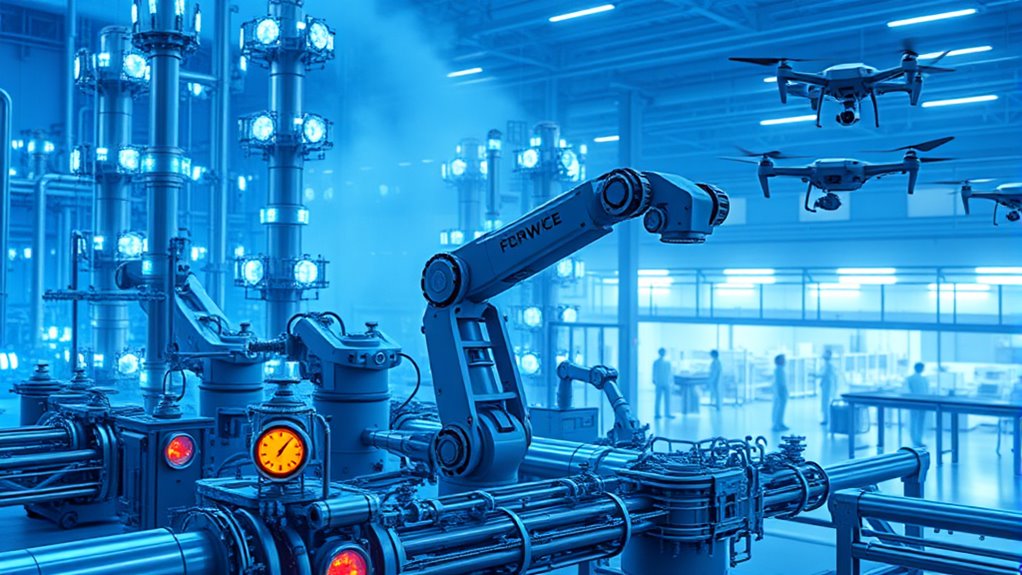
You’ll see automation transforming sectors like oil and gas by improving safety and reducing costs through real-time monitoring and predictive maintenance. In pharmaceuticals, automation enhances precision and speeds up drug development, ensuring regulatory compliance. Meanwhile, chemical industries benefit from optimized processes that boost efficiency and sustainability.
Oil & Gas Safety
Automation is transforming safety protocols in the oil and gas industry by enabling real-time monitoring, predictive maintenance, and faster response to hazards. With advanced sensors and control systems, you can detect equipment anomalies instantly, preventing failures and reducing downtime. Predictive maintenance identifies potential issues before they escalate, minimizing accidents and operational disruptions. Data analytics provide critical insights, helping you make informed decisions that enhance safety measures. Automation also accelerates hazard detection, allowing swift responses to emergencies, consequently protecting personnel and the environment. As the sector invests heavily in these technologies, safety becomes more proactive rather than reactive. This shift not only reduces risks but also lowers operational costs by decreasing human error and ensuring consistent performance across operations.
Pharma Precision Gains
How is the pharmaceutical industry harnessing cutting-edge technologies to achieve unprecedented precision? By integrating AI, machine learning, IoT, and blockchain into Pharma 4.0, you’re building intelligent, connected manufacturing ecosystems. These digital tools enable real-time decision-making and supply chain transparency, boosting agility and efficiency. Predictive analytics help optimize production schedules and catch quality issues early, reducing waste and delays. Automation in aseptic manufacturing, like robotic liquid handling, improves accuracy and reproducibility while minimizing contamination risks. AI also accelerates drug discovery, especially for personalized medicines such as cancer vaccines. As automation advances, some production might even occur closer to hospitals, supporting tailored treatments. Overall, these innovations are transforming pharma into a more precise, responsive industry that better meets individual patient needs.
Chemical Efficiency Boosts
The chemical industry is rapidly advancing toward more integrated and sustainable automation systems, driven by the need to optimize processes and reduce environmental impact. You’ll see AI and machine learning central to this shift, predicting maintenance, improving quality, and enhancing efficiency. Modular systems allow quick deployment and easier maintenance across diverse equipment. Interoperability ensures systems from multiple vendors work seamlessly, boosting flexibility. Sustainability remains a key focus, with automation reducing energy use and emissions. Here’s how these trends shape the industry:
| Trend | Impact |
|---|---|
| AI & ML Integration | Optimizes processes and predicts failures |
| Modular Systems | Faster deployment, easier maintenance |
| Interoperability | Seamless integration across vendors |
| Sustainability | Reduced energy consumption and environmental footprint |
Economic Benefits and Workforce Changes in the Age of Automation
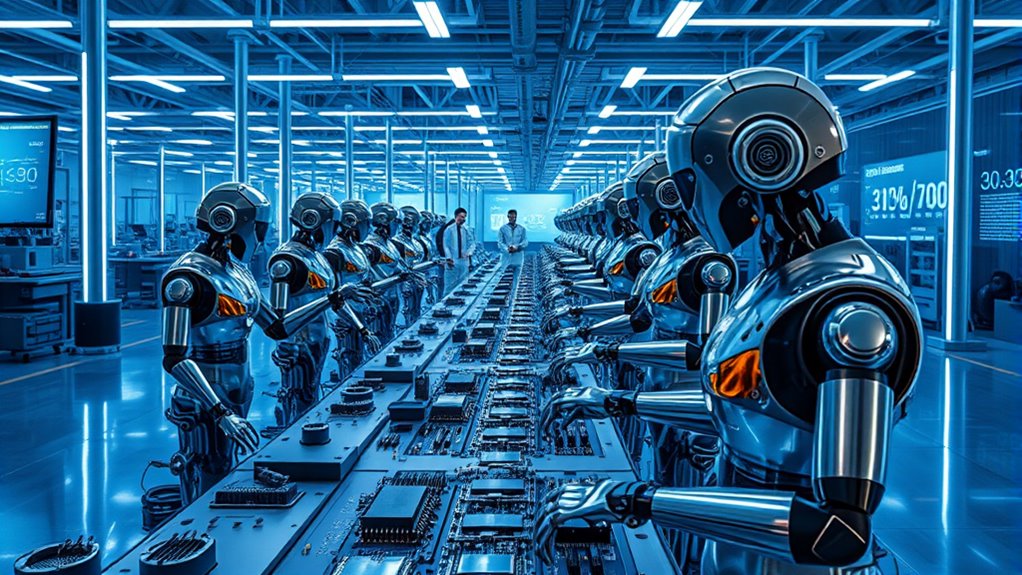
By 2030, the global economy is expected to gain around $15.7 trillion from automation and AI, mainly from productivity improvements and new consumer offerings. You’ll see productivity boost by $6.6 trillion, while innovation drives $9.1 trillion in value through new products and services. Countries like China could see a 26% GDP increase, and North America 14.5%, highlighting significant economic growth. Automation will replace about 30% of jobs globally, but also create 170 million new roles, with 92 million displaced. Many workers believe automation will lead to higher-skilled opportunities. In industries like manufacturing, logistics, and digital advertising, automation improves efficiency, speeds up production, and enhances decision-making. Overall, automation will reshape industries, generate economic growth, and shift workforce skills toward higher-value roles.
Challenges and Risks Facing Widespread Automation Adoption
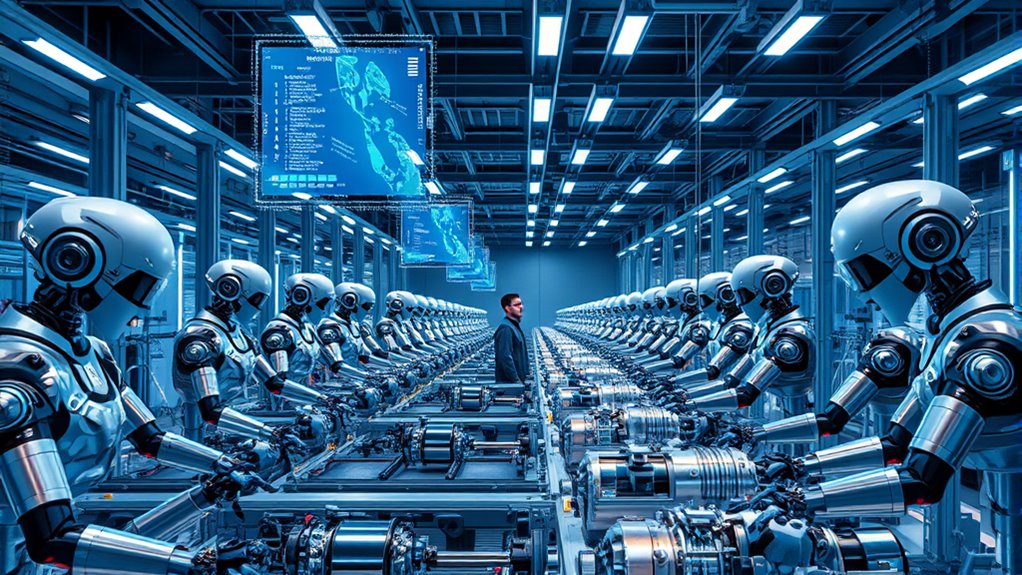
As automation drives significant economic growth and reshapes industries, it also introduces a range of challenges and risks that organizations must confront. High costs and financial barriers make initial investments steep, especially for small and medium enterprises, with unclear ROI and ongoing maintenance expenses. You’ll face:
- Workforce and Skills Transition: Job displacement, skill mismatches, and the need for costly training can create instability and resistance.
- Technological Integration: Compatibility issues with legacy systems, reliability concerns, and data interoperability complicate implementation.
- Environmental and Ethical Risks: Increased energy use, e-waste, resource depletion, cybersecurity threats, and privacy issues pose sustainability and safety challenges.
Addressing these hurdles requires strategic planning, substantial investment, and careful change management to guarantee successful adoption.
Future Innovations: AI, Machine Learning, and Connected Enterprises
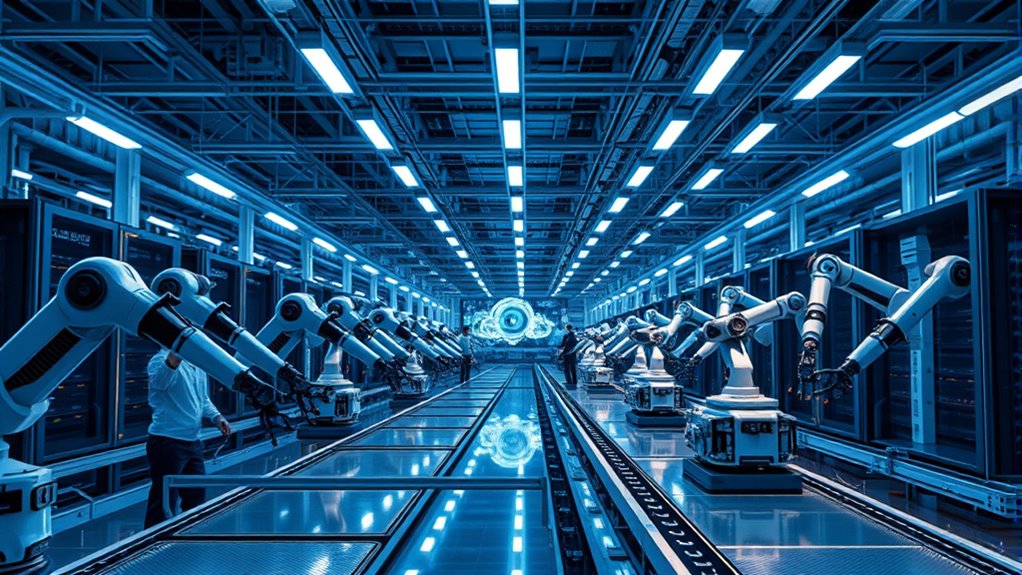
Advancements in AI, machine learning, and connected enterprise technologies are transforming industries at a rapid pace, driving increased efficiency and innovation. The global AI market in industrial automation is expected to grow considerably, adding $15.7 trillion to the economy by 2030. As AI integrates into manufacturing, you’ll see improvements in predictive maintenance, quality control, and supply chain management through advanced data analysis. Connected enterprises leverage digital tools, real-time data, and IoT devices to streamline operations and enhance decision-making. These innovations enable process optimization, workforce augmentation, and cost reduction. AI and automation work synergistically to boost productivity, foster industry-wide innovation, and create millions of new jobs, even as some roles are displaced. This technological evolution will shape your industry’s future landscape dramatically.
Preparing for a Future Where Robots Play a Central Role
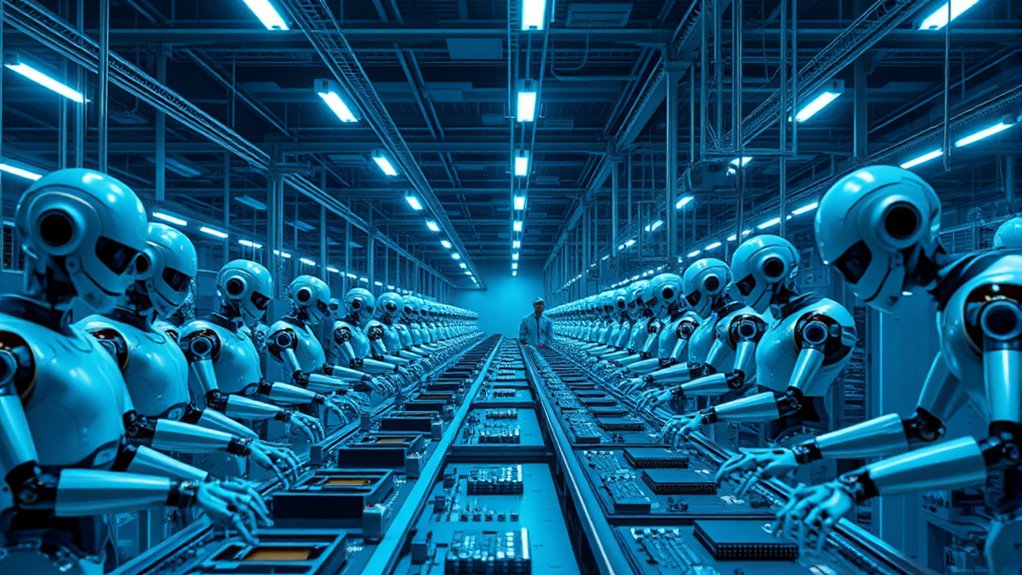
Automation technologies are rapidly reshaping manufacturing landscapes, with robots taking on a central role in driving efficiency and innovation. To prepare for this shift, you need to focus on three key areas:
Automation is transforming manufacturing, with robots leading the way in boosting efficiency and innovation.
- Adapting your workforce: Train employees to work alongside robots and develop new skills for operating advanced automation systems.
- Investing in flexible solutions: Implement reprogrammable and collaborative robots that can handle various tasks and adapt to changing demands.
- Embracing technological advancements: Stay updated on sensor, AI, and safety innovations to guarantee your automation systems remain competitive.
Frequently Asked Questions
How Will Automation Impact Global Supply Chain Resilience?
Automation will boost your supply chain resilience by providing real-time visibility and predictive insights, allowing you to anticipate disruptions and respond quickly. It diversifies sourcing options and streamlines operations, reducing reliance on manual processes. With autonomous vehicles and digital twins, you’ll gain more control and flexibility. However, you’ll also need to invest in cybersecurity and workforce upskilling to fully capitalize on automation’s resilience benefits.
What Are the Cybersecurity Risks Associated With Increased Automation?
You should be aware that increased automation heightens cybersecurity risks, such as malware, ransomware, and phishing attacks targeting connected systems. You might face insider threats or supply chain vulnerabilities, especially with outdated hardware. To protect your operations, you need robust measures like intrusion detection, data encryption, and regular system updates. Staying vigilant and proactive guarantees your automation remains secure against evolving cyber threats.
How Will Automation Influence Small and Medium-Sized Enterprises?
You’ll find automation boosting your SME’s productivity, cutting costs, and enhancing customer satisfaction. It streamlines routine tasks, freeing your team for strategic work, while reducing errors and increasing efficiency. Automation also fosters innovation, helping you stay competitive and adapt to market changes. With AI integration and smarter workflows, you’ll improve service delivery and optimize marketing efforts. By embracing automation now, you position your business for growth and resilience in a rapidly evolving landscape.
What New Skills Will Workers Need in an Automated Industry?
In an automated industry, you’ll need to develop new skills to stay relevant. Focus on advanced IT, programming, AI, and cybersecurity, as demand for these grows. Enhance your social skills like emotional intelligence, creativity, and communication to collaborate effectively with machines and teams. Also, strengthen your cognitive abilities, including data analysis, strategic thinking, and continuous learning, to adapt quickly and thrive in evolving, tech-driven workplaces.
How Can Industries Ensure Ethical Use of AI and Robotics?
Imagine guiding a ship through calm yet complex waters. To guarantee ethical use of AI and robotics, you should develop clear internal policies, establish dedicated committees, and align with global standards. Regularly audit your systems for bias and transparency, incorporate feedback, and stay vigilant with real-time monitoring. Educate your team on responsible AI practices, fostering a culture of accountability and trust, so your industry navigates innovation responsibly and ethically.
Conclusion
As automation becomes the heartbeat of your industry, think of it as a powerful engine propelling you into the future. Embracing these changes means you’re steering through uncharted waters, but with innovation as your compass, you’ll navigate confidently. Stay adaptable and ready to harness new technologies—because in this swiftly evolving landscape, those who ride the wave of automation will find themselves ahead of the tide, shaping a smarter, more efficient tomorrow.
